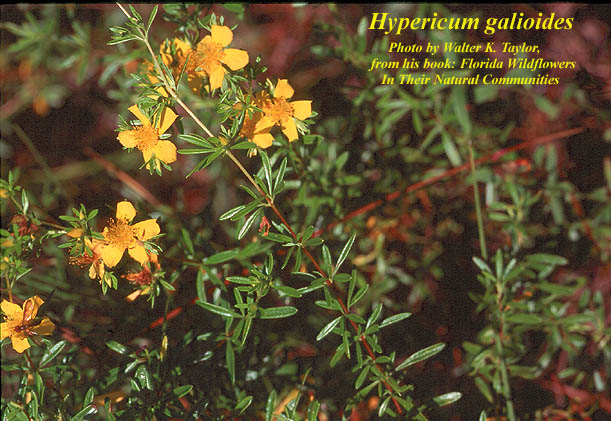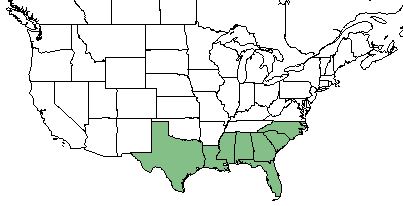Difference between revisions of "Hypericum galioides"
(→Ecology) |
(→Habitat) |
||
| Line 29: | Line 29: | ||
==Ecology== | ==Ecology== | ||
| − | ===Habitat=== | + | ===Habitat===<!--Natural communities, human disturbed habitats, topography, hydrology, soils, light, fire regime requirements for removal of competition, etc.--> |
| − | ''H. galioides'' is commonly found in wet pine savannas and flatwoods, pools, edges of bottomlands. <ref name= "Weakley"> Weakley, A. S. (2015). Flora of the Southern and Mid-Atlantic States. Chapel Hill, NC, University of North Carolina Herbarium.</ref>, and lowlands. <ref name= "brockway">Brockway, D. G. and C. E. Lewis (1997). "Long-term effects of dormant-season prescribed fire on plant community diversity, structure and productivity in a longleaf pine wiregrass ecosystem." Forest Ecology and Management 96: 167-183.</ref> | + | ''H. galioides'' is commonly found in wet pine savannas and flatwoods, pools, edges of bottomlands. <ref name= "Weakley"> Weakley, A. S. (2015). Flora of the Southern and Mid-Atlantic States. Chapel Hill, NC, University of North Carolina Herbarium.</ref>, and lowlands. <ref name= "brockway">Brockway, D. G. and C. E. Lewis (1997). "Long-term effects of dormant-season prescribed fire on plant community diversity, structure and productivity in a longleaf pine wiregrass ecosystem." Forest Ecology and Management 96: 167-183.</ref> Specimens of the species have been collected from habitats including edge of swampy woods, moist loamy sands near a vernal pool, low wet swale in a prescribed fire pine region, pine plantation, oak hammock, and longleaf pine savanna. <ref name = "FSU herbarium"> URL: http://herbarium.bio.fsu.edu. Last accessed: June 2018. Collectors: Loran Anderson, R.K. Godfrey, R.A. Norris, R.F. Doren, R.Komarek, William Platt, Cecil Slaughter, Palmer Kinser, Richard Carter, W. Baker. States and counties: Florida (Wakulla, Levy, Calhoun, Gadsden, Leon, Liberty, Baker, St. Johns, Gulf) Georgia (Decatur, Thomas) Louisiana (Beauregard)</ref> It is listed by the USDA Natural Resources Conservation Service as an obligate wetland species that is almost exclusively found in wetland habitats.<ref name= "USDA"> [https://plants.usda.gov/core/profile?symbol=CEAM USDA Plant Database]</ref> |
| − | |||
| − | |||
| − | |||
| − | |||
===Phenology=== | ===Phenology=== | ||
''H. galioides'' generally flowers from June until August.<ref name= "Weakley"/> It has been observed flowering in May and June. <ref name= "Pan Flora"> Nelson, G. PanFlora: Plant data for the eastern United States with emphasis on the Southeastern Coastal Plains, Florida, and the Florida Panhandle. www.gilnelson.com/PanFlora/ Accessed: 22 MAY 2018</ref> | ''H. galioides'' generally flowers from June until August.<ref name= "Weakley"/> It has been observed flowering in May and June. <ref name= "Pan Flora"> Nelson, G. PanFlora: Plant data for the eastern United States with emphasis on the Southeastern Coastal Plains, Florida, and the Florida Panhandle. www.gilnelson.com/PanFlora/ Accessed: 22 MAY 2018</ref> | ||
Revision as of 17:01, 23 May 2019
Common Names: bedstraw St. Johnswort [1]
| Hypericum galioides | |
|---|---|

| |
| Photo by the Atlas of Florida Plants | |
| Scientific classification | |
| Kingdom: | Plantae |
| Division: | Magnoliophyta - Flowering plants |
| Class: | Liliopsida - Moncots or Magnoliopsida - Dicots |
| Order: | Theales |
| Family: | Clusiaceae |
| Genus: | Hypericum galioides |
| Species: | H. galioides |
| Binomial name | |
| Hypericum galioides Lam. | |

| |
| Natural range of Hypericum galioides from USDA NRCS Plants Database. | |
Contents
Taxonomic Notes
Synonyms: H. ambiguum Elliott
Description
G. galioides is a perennial subshrub in the Clusiaceae family that is native to North America. [1]
Distribution
H. galioides is found throughout the southeastern United States, specifically in Florida, Georgia, South Carolina, North Carolina, Alabama, Louisiana, Mississippi, and Texas. [1]
Ecology
Habitat
H. galioides is commonly found in wet pine savannas and flatwoods, pools, edges of bottomlands. [2], and lowlands. [3] Specimens of the species have been collected from habitats including edge of swampy woods, moist loamy sands near a vernal pool, low wet swale in a prescribed fire pine region, pine plantation, oak hammock, and longleaf pine savanna. [4] It is listed by the USDA Natural Resources Conservation Service as an obligate wetland species that is almost exclusively found in wetland habitats.[1]
Phenology
H. galioides generally flowers from June until August.[2] It has been observed flowering in May and June. [5]
Fire ecology
H. galioides is not fire resistant.
Conservation and Management
Cultivation and restoration
Photo Gallery
References and notes
- ↑ 1.0 1.1 1.2 1.3 USDA Plant Database
- ↑ 2.0 2.1 Weakley, A. S. (2015). Flora of the Southern and Mid-Atlantic States. Chapel Hill, NC, University of North Carolina Herbarium.
- ↑ Brockway, D. G. and C. E. Lewis (1997). "Long-term effects of dormant-season prescribed fire on plant community diversity, structure and productivity in a longleaf pine wiregrass ecosystem." Forest Ecology and Management 96: 167-183.
- ↑ URL: http://herbarium.bio.fsu.edu. Last accessed: June 2018. Collectors: Loran Anderson, R.K. Godfrey, R.A. Norris, R.F. Doren, R.Komarek, William Platt, Cecil Slaughter, Palmer Kinser, Richard Carter, W. Baker. States and counties: Florida (Wakulla, Levy, Calhoun, Gadsden, Leon, Liberty, Baker, St. Johns, Gulf) Georgia (Decatur, Thomas) Louisiana (Beauregard)
- ↑ Nelson, G. PanFlora: Plant data for the eastern United States with emphasis on the Southeastern Coastal Plains, Florida, and the Florida Panhandle. www.gilnelson.com/PanFlora/ Accessed: 22 MAY 2018